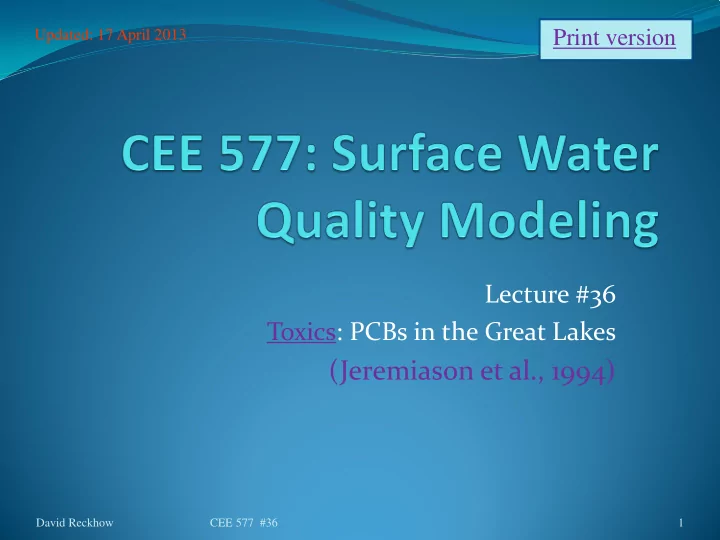

Updated: 17 April 2013 Print version Lecture #36 Toxics: PCBs in the Great Lakes (Jeremiason et al., 1994) David Reckhow CEE 577 #36 1
Homologs (11) What are the PCBs Isomers (1-46) Congeners (209) 3 2 2 3 Biphenyl 1 1’ 4’ 4 6’ 5’ 5 6 Cl 2,2’ - Dichlorobiphenyl 2,3’ - Dichlorobiphenyl Cl Cl Cl David Reckhow CEE 577 #36 2
History 1930: Monsanto is major US producer 1970: Monsanto decides to sell PCBs only for closed use 1975: NY State warns public about salmon and bass in Hudson 1979: PCB manufacture banned in US 1982: NY State begins dredging “hot spots” 1990: all PCB-containing equipment must be removed from US public buildings David Reckhow CEE 577 #36 3
Arochlor Mixtures Arochlor 12xx (xx=% chlorine) 1221: 50% Cl 1 , 35% Cl 2 1232: 26% Cl 1 , 29% Cl 2 , 24% Cl 3 1242: 13% Cl 2 , 45% Cl 3 , 31% Cl 4 1248: 49% Cl 4 , 27% Cl 5 1254: 15% Cl 4 , 53% Cl 5 , 26% Cl 6 1260: 12% Cl 5 , 42% Cl 6 , 38% Cl 7 1262: no data 1268: no data David Reckhow CEE 577 #36 4
PCBs in the Lake Superior Reference: “PCBs in Lake Superior, 1978-1992: Decrease in Water Concentrations Reflect Loss by Volatilization,” by Jeremiason, Hornbuckle and Eisenreich, Environmental Science and Technology, 28:903 (1994) St. Mary’s River David Reckhow CEE 577 #36 5
Empirical Models ( ) = ∑ ∑ − 0 20 . t PCB PCB e 25 25 o ( ) = ∑ ∑ − 0 22 . t PCB PCB e 82 82 o Data tell us that about 26,500 kg has been lost from the water column between 1980 and 1992 David Reckhow CEE 577 #36 6
Loss rate and K ow ’s Log Kow -0.6 -0.5 -0.4 k (/yr) k (yr-1) -0.3 k-regr. -0.2 -0.1 0 4.5 5 5.5 6 6.5 7 7.5 David Reckhow CEE 577 #36 7
Areal Sediment Burden (mass) Estimated at 4900 kg in 1986 using data from sediment cores relatively small compared to total lost from water column (26,500 kg from ‘80 to ‘92) ∑ ∑ = 1 φ ρ − PCB PCB ( ) z areal i i s i Thickness of depth PCB conc. (ng/g-dry increment “i” sediment) in depth increment “i” Porosity of increment “i” David Reckhow CEE 577 #36 8
Inputs = W Qc ( ) Riverine = 13 54 10 . x L yr / 2 ng L / = Known Q 110 kg yr / Estimate c from analysis of pristine rain Other estimates from industrial, municipal, (urban) runoff and storm sewer flows gives a combined total of about 40 kg/yr David Reckhow CEE 577 #36 9
Inputs (cont.) Direct Atmospheric deposition Surface wet deposition precipitation Area ∑ = F PCB P SA ( ) wet T rain , = 10 2 2 ng L / ( 76 cm )8. 21 10 x m = dry deposition 125 kg yr / calculated for 4 seasons, then averaged Dry particle deposition velocity (0.2 cm/s) ∑ Fraction of year when it = φ F PCB V ( SA f ) dry T air , d d is not precipitating (0.9) = 32 kg yr / Fraction of PCBs associated with particles David Reckhow CEE 577 #36 10
Outputs Outflow St. Mary’s River outflow = = 13 71 10 . / ( . 084 / ) 60 / W x L yr ng L kg yr Burial (net loss to sedimentation) estimated at 110 kg/yr from sediment cores collected in 1986 and 1990 Net Volatilization true volatilization minus gas absorption assumed to account for missing flux David Reckhow CEE 577 #36 11
Reactions NONE! “evidence does not exist to support PCB degradation in Lake Superior or any other oligotrophic, aerobic system exhibiting low ambient concentrations” David Reckhow CEE 577 #36 12
PCB Mass Balance in Lake Superior, 1986 Atmosphere Net Volatilization Atmospheric Deposition ~200 kg ~1900 kg/yr Wet 125 kg/yr Dry 32 kg/yr Other discharges ~40 kg/yr Particle Rivers Outflow Settling ~110 kg/yr ~60 kg/yr ~3000 kg/yr Water Column ~10,100 kg Recycling ~2890 kg/yr Sediment ~4900 kg Burial ~110 kg/yr David Reckhow CEE 577 #36 13
Congener-specific sedimentation Calculation of first-order net sedimentation rate Mass sedimentation rate (mg/cm 2 /yr) Inventory (or areal TSS) W sed f Fraction particulate INV p = w k sed RR Recycling ratio = downward flux (from sed trap) divided by the accumulation in the sediment David Reckhow CEE 577 #36 14
Sedimentation vs overall loss rate Log Kow -0.6 -0.5 -0.4 k (yr-1) k (/yr) -0.3 ksed (yr-1) k-regr. -0.2 -0.1 0 4.5 5 5.5 6 6.5 7 7.5 David Reckhow CEE 577 #36 15
Two Film Volatilization Model K Jeremiason’s equation = ol k f vol w h v Same as Chapra’s = v k H f v d 1 1 Where: 1 RT 1 = + K k H k ol a w David Reckhow CEE 577 #36 16
Estimating 2-film parameters The gas film coefficient = + k 0 2 . u 0 3 . a H O , 10 2 0 61 . D = PCB air , k k a PCB , a H O , D 2 The liquid film coefficient H O air , 2 = 1 64 . k 0 45 10 . u − w CO , 0 5 . 2 Sc = PCB k k w PCB , w CO , Sc 2 CO 2 Kinetic viscosity: molecular diffusivity Schmidt Number David Reckhow CEE 577 #36 17
Volatilization vs overall loss rate Log Kow -0.7 -0.6 -0.5 k (yr-1) k (/yr) -0.4 kvol (yr-1) k-regr. -0.3 kvol-regr. -0.2 -0.1 0 4.5 5 5.5 6 6.5 7 7.5 David Reckhow CEE 577 #36 18
To next lecture David Reckhow CEE 577 #36 19
Recommend
More recommend